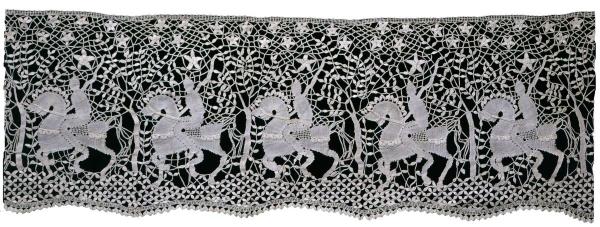The Valance "Cavalry"
Kirishsky district, Leningrad region. 1940
- Сцепное плетение. 28 х 95
- К-1078
- Period Early 20th century
- Share
Zakhozhie, the centre of lacemaking in the Kirishsky district, Leningrad region, was discovered only in the 1930s thanks to the scientific expeditions of the Russian Museum and the works of the research fellow K. Bolsheva. The lace in Zahozhie was created for the decoration of the house. Favourite objects there were covers on beds, napkins, valances and the ends of towels. The peaceful, unhurried course of village life found reflection in the character of local patterns.
The craftswomen have preserved throughout the decades all its techniques and elements, including both the special transparency of blurred patterns and their simplicity.
This craft was almost unknown before the October Revolution. Local lace was sold under the guise of those ones from Vologda. That’s why the bright rise of art in Zakhozhie in the 1930s and the response of the lace-makers to contemporary epoch appeared to be so interesting. The letters "RSFSR" (abbreviation of Russian Soviet Federative Soviet Federative Socialist Republic) , the stars, the hammer and sickle are weaved in the lace ornament. The depictions of the national emblem of the USSR (the Union of Soviet Socialist Republics) became a part of the lace pattern as well. Many craftswomen participated in the exhibitions and created their works especially for the museum. In 1940, Elizaveta Zvezdina, a talented lace-maker from the Dunyakovo village, performed the unique valance "Cavalry", which made the lace from Zakhoshie famous. In this bright and unusual in the weaving technique work, Zvezdina conveyed a contemporary subject, having depicted the border guards on patrol. This is the first image of a man in the Soviet lacemaking. The figures of riders among the trees branches and stars stand out in silhouettes on the transparent background.

